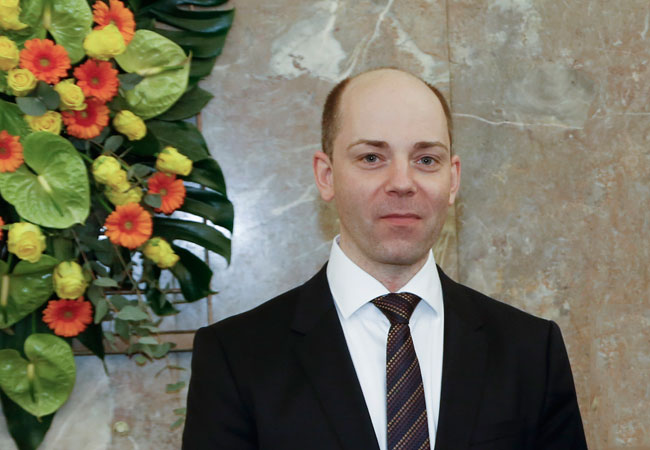
Fat cells, or adipocytes, regulate body temperature and energy consumption but they can also cause illness. The prizewinner is studying how different fat cells develop, how they work, and how this effect can be adopted to improve health, especially in old age.
Professor Tim J. Schulz from the German Institute of Human Nutrition (DIfE) in Potsdam-Rehbruecke will today receive the €60,000 Paul Ehrlich and Ludwig Darmstaedter Prize for Young Researchers for 2018 in the Paulskirche in Frankfurt. The biochemist is receiving the award for his basic research on the development of white and brown fat and on their effects on health and nutritional physiology. Schulz showed how stem cells produce white and brown fat and how white fat harms bone health in old age. Furthermore, he demonstrated that a class of drugs often used in the treatment of diabetes also reduces the harmful effects of white fat cells on bones. These medicines may improve bone health among elderly people. „The work of Tim J. Schulz addresses the highly topical issue of adiposity,“ wrote the Scientific Council in substantiating its decision. „Schulz not only takes into consideration the negative effects of white adipose tissue but also examines whether adiposity and the diseases it fosters can be prevented by the targeted production of more brown adipose tissue and the role of nutrition during this scenario.“ The Paul Ehrlich and Ludwig Darmstaedter Prize for Young Researchers will be presented by Professor Thomas Boehm, Managing Director at the Max Planck Institute of Immunobiology and Epigenetics in Freiburg and Chairman of the Scientific Council.
White and brown fat are not the same. Brown fat regulates body temperature and protects it from cooling. White adipose tissue stores unused energy from food and is hardly utilized at all in contemporary high-calorie diets. Too much white fat is burdensome for the body and may drive disease development. Moreover, as people age they store more white fat in the organs and bones and not only in subcutaneous tissue. As a result, this fatty degeneration may contribute to the development of many diseases that occur more frequently in old age such as diabetes, fatty liver or poor bone healing.
Brown and white fat cells, like all the body’s other cells, descend from stem cells. Brown fat, though, derives from specialized brown fat stem cells dedicated to that purpose. It was once believed that only neonates and young children had this invaluable resource, but that is not the case. Adults have brown fat, especially in the upper body, in particular along the shoulder blades, in deep regions of the neck, the large blood vessels, and along the spinal column. Schulz studies the development of brown fat cells from stem cells and was part of a team that showed that their formation can be controlled by a special signaling molecule. This fits in with a well-known approach of combating adiposity by increasing the amount of brown fat. This approach aims to convert the unnecessary calories to heat in the brown fat deposits rather than storing them in the white fat deposits. Brown fat could thus be a weight loss treatment. Schulz also showed that the brown fat stem cells lose their capability to create more brown fat during aging. He identified the relevant aspects and target molecules of this aging process and hopes that some of them can be used therapeutically.
His findings on the role of white fat in bone also have important implications. Schulz demonstrated that with advancing age and a fat-enriched diet bone stem cells produce white fat rather than healthy bone tissue. This fat is harmful for bone not only because of its presence but also because it produces other molecules that make it even more difficult for the stem cells to generate new bone tissue which might explain why bones heal poorly in old age. Added to this is the fact that white fat also damages the hematopoietic stem cells of bone marrow which could results in reduced blood cell formation in bone with excess fatty infiltration. Schulz further demonstrated that a drug class widely used to treat diabetes inhibits an enzyme that is produced by white fat cells in the bones. This class of agents is known as gliptins. It remains to be determined in clinical trials whether they can improve bone health in the elderly in addition to the known beneficial effect in diabetes. Schulz is currently involved in studying how the composition of the diet affects bone stem cells and whether certain forms of nutrition can promote bone healing through the activation of the stem cells.
Short Biography of Professor Tim Julius Schulz
Tim J. Schulz (39) was born in Northeim, Germany, and studied biochemistry at Potsdam University. He received his PhD in 2007 under Professor Michael Ristow at the Friedrich Schiller University in Jena. He was awarded the Dissertation Prize of the Biological-Pharmaceutical Faculty for his thesis. On completing his PhD, Schulz spent five years at the Joslin Diabetes Center in Boston, which is part of the Harvard Medical School. He worked there with Professor Yu-Hua Tseng in the Department of Integrative Physiology and Metabolism. From 2012 to 2016 Schulz headed the Emmy Noether Young Investigator Group „Adipocyte Development“, sponsored by the German Research Foundation, at the German Institute of Human Nutrition Potsdam-Rehbruecke (DIfE). In 2016 Schulz was appointed head of the department of „Adipocyte Development and Nutrition“ at the DIfE, a partner of the German Center for Diabetes Research (DZD). At the same time he was appointed W2 professor at Potsdam University. In 2013 he was awarded a €1.5 million starting grant of the European Research Council (ERC).
Paul Ehrlich and Ludwig Darmstaedter Prize for Young Researchers
The Paul Ehrlich and Ludwig Darmstaedter Prize for Young Researchers, awarded for the first time in 2006, is conferred once a year by the Paul Ehrlich Foundation on a young investigator working in Germany for his or her outstanding achievements in the field of biomedical research. The prize money must be used for research purposes. University faculty members and leading scientists at German research institutions are eligible for nomination. The selection of the prizewinner is made by the Scientific Council on a proposal by the eight-person selection committee.
The Paul Ehrlich Foundation
The Paul Ehrlich Foundation is a legally dependent foundation which is managed in a fiduciary capacity by the Association of Friends and Sponsors of the Goethe University, Frankfurt. The Honorary Chairman of the Foundation, which was established by Hedwig Ehrlich in 1929, is Professor Dr. Peter Strohschneider, president of the German Research Foundation, who also appoints the elected members of the Scientific Council and the Board of Trustees. The Chairman of the Scientific Council is Professor Thomas Boehm, Managing Director at the Max Planck Institute of Immunobiology and Epigenetics in Freiburg, the Chair of the Board of Trustees is Professor Dr. Jochen Maas, Head of Research and Development and Member of the Management Board, Sanofi-Aventis Deutschland GmbH. Professor Wilhelm Bender, in his function as Chair of the Association of Friends and Sponsors of the Goethe University, is Member of the Scientific Council. The President of the Goethe University is at the same time a member of the Board of Trustees.
Source: Press Release 14/03/2018









